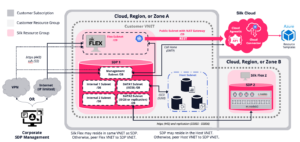About Silk
Silk offers the flexibility and high performance that organizations need to leverage the public cloud. The Silk Data Virtualization Platform is a combination of tested and packaged software and services. Silk provides a rich set of data services, machine learning, analytics, and policy-based automation and orchestration.
Use this guide to learn about the prerequisites to successfully deploy Silk onto your instance of Microsoft Azure.
Refer to the following guides for more information about the prerequisites, steps involved, architecture, security, and networking requirements to successfully deploy Silk onto your instance of Microsoft Azure.
- Deploying Silk – Overview & Background
- How to Deploy Silk
- Architecture Requirements to Deploy Silk
- Security Requirements to Deploy Silk
- Networking Requirements to Deploy Silk
Network Requirements Overview
The following sections detail networking requirements for Silk, including subnets, interfaces, replication, connectivity, and other details.
Figure 1 below shows an overview of a possible Silk deployment configuration highlighting some of the protocols, ports, and networking settings that this document will cover.
Figure 1: Silk Networking Architecture in Azure
Network: Accelerated Networking
Silk recommends enabling Accelerated Networking on the host virtual machines for the databases that will be connected to Silk. Silk enables Accelerated networking on the c.nodes of Silk Data Pods (SDPs).
Network: Subnets
Use the following subnets configurations to deploy Silk Flex from the Azure Marketplace.
- Provide a small /28 subnet for the Silk Flex Cluster. An example address space is shown below:
10.140.140.0 /28 - Silk requires that the operator/administrator has access to the following from their workstation:
- Silk Flex subnet
- The SDP management subnet
- The test/validation virtual machine (VM)
- Refer to the guide Networking Requirements to Deploy Silk, Section Network: Connectivity & Internet Access for more information.
- If using replication between Silk Data Pods, Silk requires a replication subnet.
Network: Interfaces
Use the following network interfaces configuration to deploy the Silk Data Pod (SDP).
- Hosts may reside within the same VNET as the SDP or in a different VNET.
- If the host resides in a different VNET from the SDP, peering between the Host and SDP VNET must be implemented.
Network: Replication
Use the following network replication configuration to deploy Silk in a High Availability and/or Disaster Recovery architecture.
- Replication sites must be able to route IP traffic to each other over the organization’s preferred WAN connection.
- This WAN connection can be attained in one of three ways:
- Via a point-to-point link that runs through a dedicated fiber,
- Via a leased WDM light wave, or
- Via site-to-site VPN.
- Each site must be able to provide at least two IP subnets:
- One for management traffic and
- One (at least) for replication traffic, i.e., one subnet per replication port on each server.
Network: Connectivity & Internet Access
The user needs a way to access the Silk Flex instance interface and Silk Data Pod (SDP) interface from the machine(s) that they will use to access these interfaces.
- Silk requires the operator/administrator to have access to the following from their workstation:
- Silk Flex subnet (https access via port 443)
- SDP management subnet (https or SSH access via port 443)
- Test/validation virtual machine (VM) (via port 22 for Linux VMs or 3389 for Windows VMs). Alternatively, use terminal access for Linux VMs and RDP access for Windows VMs.
- The Silk Flex deployment process requires egress internet access.
- When deploying an SDP for the first time, the operator/administrator needs to have the ability to copy software such as Java and VDbench to the test VM.
- Management of Silk Flex and SDPs may be accomplished over the internet if allowed by either of the following:
- Via a VPN configured to allow https and ssh to Silk Flex and/or the SDP, or
- Via a Bastion or Jump host with https and ssh access to Silk Flex and/or the SDP.

